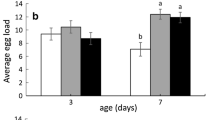Abstract
Aphelinus flavus Thompson is a solitary internal parasite. Males and females overwinter as free living adults and appear on sycamore in mid, May. The female consumes aphid body fluids and kills 1 aphid for food for every 1.7 eggs deposited, and parasitises 48 aphids over 27 days. Development from egg to adult requires and parasitises 48 aphids over 27 days. Development from egg to adult requires 57 days. The mortality of parasites while within the nummified host was determined: it was related to hyperparasitism and predation. Mortality due to mummies being brushed off the leaves was also determined.
Résumé
Aphelinus flavus apparaît sur le Sycomore à la mi-mai lorsque les fondatrices de son hôte sont mûres. La femelle du parasite consomme les liquides du corps des pucerons pour acquérir les substances nécessaires à la maturation des œufs. Il faut le liquide de 1 puceron pour le développement de 1,7 œuf. Elle parasite 48 pucerons dans un délai de 27 jours. 23 jours après avoir été parasité le puceron meurt dans sa momie.A. flavus termine son développement et il sort 34 jours plus tard. Il y a en général 2 générations annuelles du parasite, l'importance de la seconde génération dépend de l'époque du début de la reproduction des pucerons adultes après la période estivale de diapause.
Les parasites de la première génération ne pondent pas après le début août de sorte que la deuxième génération atteint le stade adulte avant la chute des feuilles. Elle hiverne à l'état d'adultes, libres.A. flavus a besoin des très petits stades de pucerons pour les parasiter et s'alimenter. Les parasites à l'intérieur des pucerons momifiés subissent une mortalité considérable due aux hyperparasites, à la disparition des feuilles et à l'action d'Anthocorides.
Similar content being viewed by others
References
Ainslie, C. N. — 1909. The manner of attachment of parasitised aphids. —Ent. News,20, 110–112.
Behrendt, K. — 1958. Das Abwandern parasitierter Aphiden von ihren Wirtspflanzen und eine Methode zu ihrer Erfassung. —Beitr. Ent.,18, 293–298.
Dixon, A. F. G. — 1963. Reproductive activity of the sycamore aphidDrepanosiphum platanoides Schr. —J. anim. Ecol.,32, 33–48.
— — 1966. The effect of population density and nutritive status of the host on the summer reproductive activity of the sycamore aphidDrepanosiphum platanoides Schr. —J. anim. Ecol.,35, 105–112.
— — 1971. The “interval timer” and photoperiod in the determination of parthenogenetic and sexual morphs in the aphidDrepanosiphum platanoides. —J. Insect Physiol.,17, 251–260.
Dixon, A. F. G., &Russel, R. J. — 1972. The effectiveness ofAnthocoris nemorum andA. confusus [Hemiptera: Anthocoridae] as predators of the sycamore aphid,Drepanosiphum platanoides. II. Searching behaviour and the incidence of predation in the field. —Ent. exp. appl.,15, 35–50.
Ferrière, C. — 1965.Hymenoptera, Aphelinidae d'Europe et du Bassin Méditerranéen. —Masson et Cie, Paris, 206 pp.
Flanders, S. E. — 1951. Mass culture of California red scale and its golden Chalcid parasite. —Hilgardia,21, 1–42.
— — 1953. Predatism by the adult hymenopterous parasite and its role in biological control. —J. econ. Ent.,46, 541–544.
Hartley, E. A. — 1922. Some bionomics ofAphelinus semiflavus Howard. —Ohio J. Sci. 22, 209–236.
Lundie, A. E. — 1924. A biological study ofAphelinus mali Hald., a parasite of the woolly apple aphid,Eriosoma lanigera Hausm. —Mem. Cornell Univ. agric. Exp. Stn., No. 79, 27 pp.
Michel, M. F. — 1967. Importance écologique du comportement prédateur d'Aphelinus asychis Walker, Hym.Aphelinidae, endoparasite de pucerons [Hom.Aphididae]. —C. R. Acad. Sci., Paris,364, 936–939.
Mordwilko, A. — 1908. Beitrage zur Biologie der Pflanzenlause,Aphididae Passerini. —Biol. Zbl.,28, 631–639.
Schlinger, E. I. &Hall, J. C., — 1959. A synopsis of the biologies of three imported parasites of the spotted alfalfa aphid. —J. econ. Ent.,52, 154–157.
Smith, B. D. — 1966. Effects of parasites and predators on a natural population of the aphidAcyrthosiphon spartii,Koch on broom. —J. anim. Ecol.,35, 255–267.
Starý, P. — 1970. Host life cycle and adaptation of parasites of the sycamore aphid.Drepanosiphum platanoides Schr. in central Europe. —Acta ent. Bohemoslov,67, 351–359.
Van Emden, H. F. — 1965. The effect of uncultivated land on the distribution of cabbage aphid (Brevicoryne brassicae) on an adjacent crop. —J. appl. Ecol. 2, 171–196.
Wilbert, H. — 1964. Das Ausleseverhalten vonAphelinus semiflavus Howard und die Abweheraktionen seiner Wirte. —Beitr. Ent.,14, 159–221.
— — 1965. Die Auswirkungen der Korpergrosse vonAphelinus semiflavus How. [Hym., Aphelinidae] auf einige Organe und ihre Leistungsfahigkeit. —Z. Morph. Oekol. Tiere,55, 804–34.
Author information
Authors and Affiliations
Rights and permissions
About this article
Cite this article
Hamilton, P.A. The biology ofAphelinus flavus [Hym. Aphelinidae], a parasite of the Sycamore aphidDrepanosiphum platanoides [Hemipt. Aphididae]. Entomophaga 18, 449–462 (1973). https://doi.org/10.1007/BF02371022
Issue Date:
DOI: https://doi.org/10.1007/BF02371022




